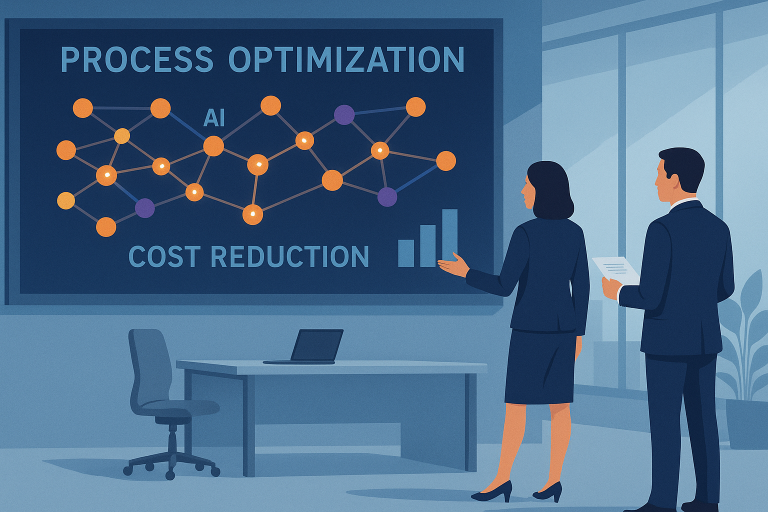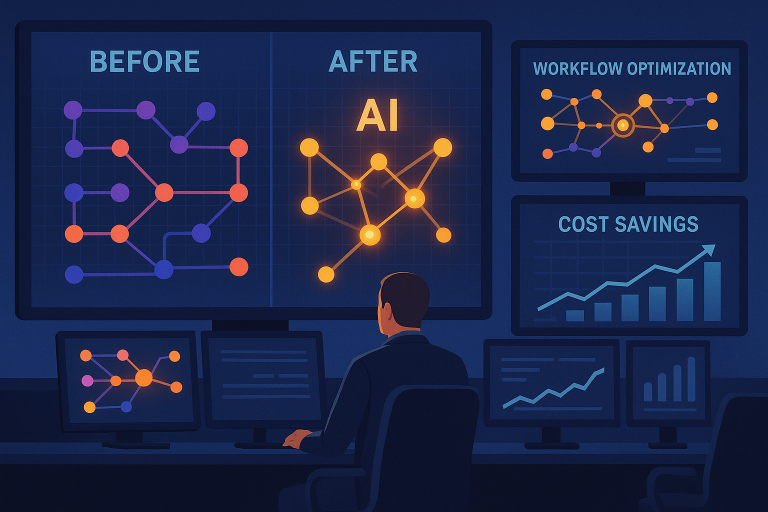Transforming Operations Through AI-Powered Workflow Cost Optimization
In today’s competitive business landscape, optimizing operational costs is no longer optional—it’s essential for survival and growth. Workflow cost optimization has emerged as a crucial strategy for businesses looking to boost efficiency while reducing expenses. Recent studies show that organizations implementing AI-driven workflow optimization can reduce operational costs by up to 30%, creating a significant competitive advantage.
Let’s explore how artificial intelligence is revolutionizing workflow economics and how your business can leverage these technologies to slash process costs while improving performance.

Understanding Workflow Cost Optimization
At its core, workflow cost optimization is the systematic analysis and improvement of business processes to maximize efficiency and minimize expenses. It involves identifying bottlenecks, eliminating redundancies, and leveraging technology to automate repetitive tasks—ultimately driving down operational costs while improving output quality.
In the digital era, workflow cost optimization has evolved from simple process tweaking to sophisticated, AI-driven transformation initiatives that can fundamentally reshape how businesses operate.
Key Drivers of Process Inefficiency
Before implementing solutions, it’s critical to understand what’s driving inefficiency in your workflows. These common culprits are likely sabotaging your operational efficiency:
- Manual data entry errors – Human errors in data entry can cost organizations 10-30% in revenue annually
- Redundant approval chains – Excessive approval steps can extend process completion by 80% without adding proportional value
- Information silos – Disconnected systems force employees to toggle between multiple platforms, with workers spending up to 30% of their time searching for information
- Underutilized automation opportunities – Many businesses automate only 25-40% of tasks that could be automated
The Financial Impact of Workflow Inefficiency
The true cost of inefficient workflows extends far beyond obvious expenses, creating a financial domino effect that impacts multiple aspects of business performance:
| Inefficiency Type | Financial Impact | Hidden Costs |
|---|---|---|
| Hidden labor costs | $5,000-$15,000 per employee annually | Employee burnout, higher turnover |
| Delayed decision making | 2-5% revenue loss per quarter | Missed market opportunities, competitive disadvantage |
| Error correction expenses | 3-8% of operational budget | Reputation damage, customer dissatisfaction |
| Compliance penalty risks | Average regulatory fine: $14.5 million | Legal expenses, operational disruptions |
With these substantial costs at stake, AI-driven process transformation isn’t just a technological upgrade—it’s a financial imperative.
How AI Transforms Workflow Economics
Artificial intelligence is fundamentally changing the economics of business processes by bringing intelligence, automation, and optimization to workflows that were previously manually intensive or plagued by inefficiencies.
Process Mining and Intelligence
Process mining technology uses AI to analyze process data and extract actionable insights about business operations. This allows organizations to:
- Automatically detect bottlenecks – AI identifies process constraints that humans might miss, reducing process cycle times by 20-30%
- Analyze process variance – By comparing actual workflows against ideal models, AI pinpoints where deviations occur and what causes them
- Create predictive workflow models – Machine learning algorithms can predict future workflow behaviors and potential issues before they occur
- Receive real-time recommendations – Continuous monitoring enables dynamic process adjustments based on changing conditions
These capabilities allow businesses to move from reactive to proactive workflow management, preventing costly inefficiencies before they impact operations.
Intelligent Document Processing
Document-heavy processes are prime candidates for AI optimization. Intelligent document processing combines several AI technologies to automate the extraction, processing, and routing of information:
- OCR and document classification – Automatically categorizes documents and extracts text from various formats
- Natural language processing – Understands document content and context, extracting relevant data points
- Automated data validation – Verifies extracted information against business rules and existing systems
- System integration – Seamlessly connects with existing enterprise systems to update records and trigger workflows
Organizations implementing intelligent document processing typically see a 60-80% reduction in processing time and a 30-50% decrease in processing costs, while significantly improving accuracy rates.
Robotic Process Automation (RPA)
RPA represents one of the most accessible entry points into AI-powered workflow optimization. These digital workers excel at:
- Rule-based task automation – Handling repetitive tasks across multiple systems without human intervention
- 24/7 process execution – Operating continuously without breaks, vacations, or shift changes
- Error reduction – Executing tasks with perfect consistency, eliminating human error
- Scalability during peak periods – Easily scaling up or down based on workflow demands
When combined with more advanced AI capabilities like machine learning, RPA becomes even more powerful, creating intelligent automation systems capable of handling increasingly complex workflows with minimal human oversight.

Measuring ROI from Workflow Optimization
Implementing AI-powered workflow optimization requires investment, making it essential to properly measure and communicate the return on investment to stakeholders.
Key Performance Indicators
Effective measurement starts with selecting the right KPIs. The most impactful metrics typically include:
- Processing time reduction – Measuring the decrease in end-to-end process duration
- Labor cost savings – Quantifying reduced labor hours or reallocation to higher-value activities
- Error rate improvements – Tracking reduction in errors and associated correction costs
- Compliance adherence metrics – Measuring improved regulatory compliance and reduced risk exposure
- Customer satisfaction impacts – Assessing improvements in customer experience resulting from optimized workflows
The most successful organizations establish baseline measurements before implementation and track improvements over time, creating a clear before-and-after picture of optimization benefits.
Cost-Benefit Analysis Framework
A comprehensive cost-benefit analysis should consider multiple dimensions:
| Consideration | Components |
|---|---|
| Implementation costs vs. operational savings | Software licensing, implementation services, and change management costs weighed against ongoing operational savings |
| Short-term vs. long-term ROI | Immediate benefits (often from automation) versus compounding benefits over time (process improvements, data insights) |
| Direct and indirect benefit quantification | Measurable cost savings plus harder-to-quantify benefits like improved employee satisfaction and customer experience |
| Risk mitigation value | Value of reduced compliance violations, security incidents, and operational disruptions |
A well-structured ROI analysis typically shows that workflow cost optimization initiatives deliver returns of 200-300% within the first year, with benefits increasing as AI systems learn and improve over time.
Implementation Roadmap
Successful AI-powered workflow optimization requires a strategic, phased approach that balances quick wins with long-term transformation.
Process Assessment and Prioritization
Begin with a comprehensive assessment of your current workflows:
- Conduct workflow audits – Document existing processes, including time, cost, and resource requirements
- Rank by cost impact – Prioritize workflows with the highest potential ROI from optimization
- Evaluate technical feasibility – Assess which processes are most suitable for AI-based optimization
- Identify quick wins – Select 1-2 high-impact, low-complexity processes for initial implementation
This structured approach ensures you target the most impactful opportunities first, building momentum for broader optimization initiatives.
Technology Selection Criteria
Choosing the right AI technologies for your workflow optimization is critical. Consider these factors when evaluating options:
- Build vs. buy considerations – Assess whether to develop custom solutions or leverage existing platforms
- Integration requirements – Ensure compatibility with your existing technology ecosystem
- Scalability factors – Evaluate the solution’s ability to grow with your business needs
- Vendor evaluation – Consider not just current capabilities but product roadmap and support
Many organizations find that starting with packaged AI solutions that address specific workflow challenges provides the fastest path to ROI, while developing a long-term technology strategy in parallel.
Change Management Strategies
The human element is often the most challenging aspect of workflow optimization. Effective change management should include:
- Stakeholder communication plans – Clear messaging about the benefits and impact of new workflows
- Comprehensive training – Equipping employees with the skills needed to work with AI-enhanced processes
- Resistance mitigation – Proactively addressing concerns about job security and changing roles
- Continuous improvement culture – Establishing feedback mechanisms to constantly refine optimized workflows
Organizations that excel at change management often see 30-50% faster adoption rates for new workflow technologies, dramatically accelerating time-to-value.
Real-World Success Stories
The impact of AI-powered workflow cost optimization is best illustrated through real-world examples across industries.
Financial Services Transformation
A mid-sized financial institution implemented AI-driven workflow optimization across its loan processing operations, achieving:
- 73% reduction in loan processing time – From application to approval
- 68% decrease in compliance-related errors – Through automated regulatory checks
- $4.2 million annual cost savings – Through reduced manual processing and error correction
- 42% improvement in customer satisfaction scores – Due to faster service and fewer errors
The institution achieved full ROI within nine months, with optimization costs fully recovered through operational savings.
Healthcare Administration Efficiency
A healthcare provider network implemented AI-powered automation for claims processing and patient record management:
- Claims processing time reduced by 62% – From an average of 14 days to 5.3 days
- Patient record errors decreased by 91% – Through intelligent document processing
- Staff redeployed to patient care – 24 FTEs shifted from administrative to care-related roles
- $3.8 million revenue cycle improvement – Through faster, more accurate billing
Beyond the financial benefits, the improved administrative efficiency significantly enhanced patient experience and provider satisfaction.
Manufacturing Supply Chain Optimization
A global manufacturer implemented AI-driven workflow optimization across its supply chain operations:
- Inventory carrying costs reduced by 31% – Through predictive inventory management
- Quality control process time decreased by 44% – Using computer vision and machine learning
- Supplier onboarding time cut by 67% – Through automated document processing
- Production planning accuracy improved by 28% – Using AI-powered demand forecasting
The manufacturer realized over $12 million in annual savings while simultaneously improving delivery times and product quality.
Future Trends in AI-Powered Cost Optimization
As AI technologies continue to evolve, we’re seeing emerging trends that will define the next generation of workflow cost optimization.
Predictive Process Optimization
The future of workflow optimization lies in prediction rather than reaction. Advanced AI systems are increasingly able to:
- Anticipate workflow adjustments – Predicting bottlenecks before they occur and automatically rerouting work
- Allocate resources dynamically – Shifting computational and human resources based on predicted demand
- Schedule preventative maintenance – Optimizing equipment uptime through predictive analytics
- Integrate demand forecasting – Aligning workflow capacity with predicted customer demands
Organizations implementing predictive process optimization are seeing an additional 15-25% efficiency gain over traditional workflow automation.
Conversational AI and Natural Interfaces
The way we interact with workflows is being transformed through natural language interfaces:
- Voice-activated process initiation – Starting and controlling workflows through spoken commands
- Chatbot-driven workflow execution – Intelligent assistants guiding users through complex processes
- Natural language queries – Accessing process insights through conversational questions
- Multimodal interaction – Combining voice, text, and visual interfaces for intuitive workflow management
These natural interfaces are dramatically reducing the learning curve for new systems and enabling workflow participation from previously excluded stakeholders.
Conclusion: The Imperative for AI-Powered Workflow Cost Optimization
In a business environment defined by margin pressure and competitive disruption, AI-powered workflow cost optimization isn’t just a technological improvement—it’s a strategic necessity. Organizations that successfully implement these technologies are not only reducing costs; they’re fundamentally transforming their operational capabilities, enabling them to move faster, serve customers better, and adapt more quickly to changing market conditions.
The time to begin your workflow optimization journey is now. Start by identifying your highest-impact processes, evaluating potential AI solutions, and developing a phased implementation plan. With a thoughtful approach and a commitment to continuous improvement, you can achieve the 20-30% cost reduction and performance improvements that leading organizations are realizing through AI-powered workflow optimization.
The question is no longer whether you should optimize your workflows with AI, but how quickly you can begin capturing the substantial benefits that await.
